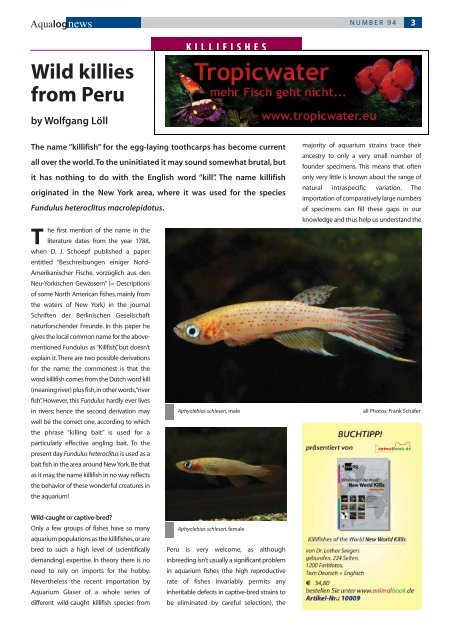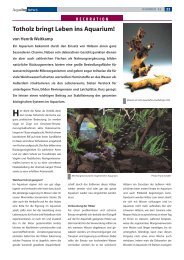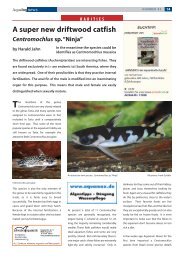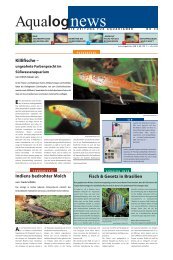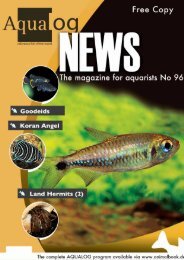LIVEBEARERS T Phallichthys tico - - a dainty new ... - Aqualog
LIVEBEARERS T Phallichthys tico - - a dainty new ... - Aqualog
LIVEBEARERS T Phallichthys tico - - a dainty new ... - Aqualog
Create successful ePaper yourself
Turn your PDF publications into a flip-book with our unique Google optimized e-Paper software.
<strong>Aqualog</strong><strong>new</strong>s NUMBER 94 3<br />
Wild killies<br />
from Peru<br />
by Wolfgang Löll<br />
T<br />
he first mention of the name in the<br />
literature dates from the year 1788,<br />
when D. J. Schoepf published a paper<br />
entitled “Beschreibungen einiger Nord-<br />
Amerikanischer Fische, vorzüglich aus den<br />
Neu-Yorkischen Gewässern” (= Descriptions<br />
of some North American fishes, mainly from<br />
the waters of New York) in the journal<br />
Schriften der Berlinischen Gesellschaft<br />
naturforschender Freunde. In this paper he<br />
gives the local common name for the abovementioned<br />
Fundulus as “Killfish”,but doesn’t<br />
explain it.There are two possible derivations<br />
for the name: the commonest is that the<br />
word killifish comes from the Dutch word kill<br />
(meaning river) plus fish,in other words,“river<br />
fish”.However,this Fundulus hardly ever lives<br />
in rivers; hence the second derivation may<br />
well be the correct one, according to which<br />
the phrase “killing bait” is used for a<br />
particularly effective angling bait. To the<br />
present day Fundulus heteroclitus is used as a<br />
bait fish in the area around New York.Be that<br />
as it may, the name killifish in no way reflects<br />
the behavior of these wonderful creatures in<br />
the aquarium!<br />
Wild-caught or captive-bred?<br />
Only a few groups of fishes have so many<br />
aquarium populations as the killifishes,or are<br />
bred to such a high level of (scientifically<br />
demanding) expertise. In theory there is no<br />
need to rely on imports for the hobby.<br />
Nevertheless the recent importation by<br />
Aquarium Glaser of a whole series of<br />
different wild-caught killifish species from<br />
KILLIFISHES<br />
The name “killifish” for the egg-laying toothcarps has become current<br />
all over the world.To the uninitiated it may sound somewhat brutal, but<br />
it has nothing to do with the English word “kill”. The name killifish<br />
originated in the New York area, where it was used for the species<br />
Fundulus heteroclitus macrolepidotus.<br />
Aphyolebias schleseri,male all Photos: Frank Schäfer<br />
Aphyolebias schleseri,female<br />
Peru is very welcome, as although<br />
inbreeding isn’t usually a significant problem<br />
in aquarium fishes (the high reproductive<br />
rate of fishes invariably permits any<br />
inheritable defects in captive-bred strains to<br />
be eliminated by careful selection), the<br />
majority of aquarium strains trace their<br />
ancestry to only a very small number of<br />
founder specimens. This means that often<br />
only very little is known about the range of<br />
natural intraspecific variation. The<br />
importation of comparatively large numbers<br />
of specimens can fill these gaps in our<br />
knowledge and thus help us understand the


